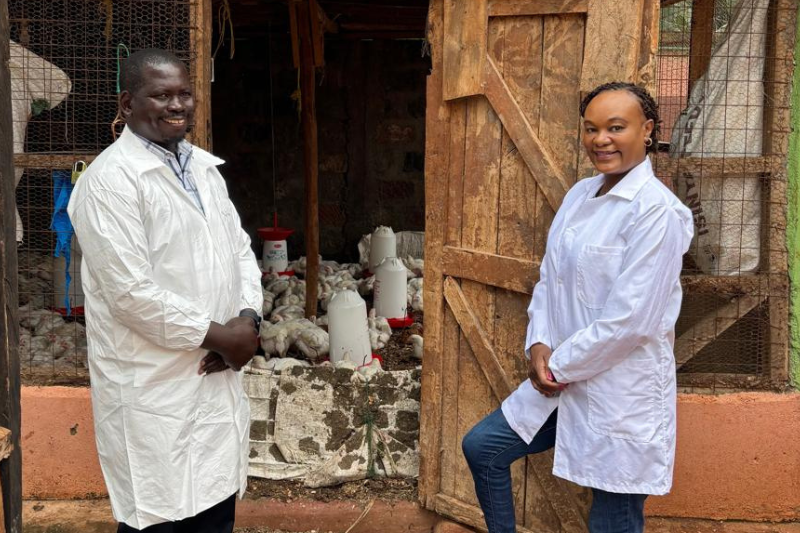
Kenyan researchers are leading an effort to strengthen food safety practices among the small and midsize poultry enterprises that feed Nairobi’s growing population. With foodborne illness estimated to cost the Kenyan economy one billion U.S. dollars annually, addressing food safety in the poultry sector is an important focus due to the impact of foodborne disease on public health, the economic costs arising from lost productivity and medical treatment, and the implications for food security and economic opportunity.
“In Kenya, where undernutrition rates are high and the population-environment balance is delicate, the poultry value chain plays a very crucial role in addressing hunger and poverty towards the United Nations’ first two Sustainable Development Goals: No Hunger and Zero Poverty,” said Professor Catherine Kunyanga, associate professor and associate dean at the University of Nairobi, who serves as co-lead PI for the project with Dr. Robert Onsare, Principal Research Scientist and Acting Deputy Director for the One Health Approach Research Program at the Kenya Medical Research Institute. “Poultry business has recently been picked up by women and youth in most parts of the country as a quick source of income and livelihood for many households because it is profitable and provides a good source of animal-based protein that assures households’ nutrition security in Kenya.”
Chicken products can provide high-quality nutrients for vulnerable populations, but contamination with bacterial foodborne pathogens remains a global challenge in poultry production and processing environments. In recent years, foodborne illnesses from Salmonella and Campylobacter have occurred at an increasing frequency in Kenya, contributing to public health concerns about foodborne illness and antibiotic resistance. The new project, funded by the Feed the Future Innovation Lab for Food Safety, will bridge key knowledge gaps and develop a training program for small-scale poultry enterprises.
The team is using three approaches to build a foundation for safer poultry. They are conducting microbiological surveys to understand current Salmonella and Campylobacter contamination levels, using whole genome sequencing to precisely characterize the bacterial isolates present in the value chain, and analyzing the roles and food safety risks to men, women, and youth involved in poultry production.
The overall goal of the microbial survey is to provide baseline data on the prevalence of contamination with Salmonella and Campylobacter in the poultry value chain. Testing for these key foodborne pathogens will occur at critical points along the chicken production chain in Kiambu County: farms where poultry is produced and processed, transport/aggregation service providers, and point-of-sale (butcheries). Whole genome sequencing will be used to genetically characterize the pathogens’ ability to cause foodborne disease, including virulence factors and antimicrobial resistance genes.
“We expect that the baseline assessments from the study will provide the much-needed data to assist the national and county governments in Kenya, farmers, researchers, poultry butchery businesses, food safety regulators, and other stakeholders in prioritizing food safety intervention efforts, training programs, research needs, and policy regarding food safety in the poultry food value chain,” said Onsare. “The project outcomes and data are expected to impact not only Kiambu County, where the project is based, but they could also be scaled up in Kenya in general with a possibility of global application in similar production systems.”
Concurrently with the pathogen survey, the team will analyze the roles of men, women, and youth in poultry production and processing and the food safety risks they face. Kunyanga noted that smallholder poultry production remains one of the key enterprises among low-income households—particularly in rural and peri-urban areas—and women and youth are currently heavily involved.
“Our preliminary data shows that women and youth possess little knowledge on safe poultry production, which makes them more exposed to foodborne pathogens and illnesses,” said Kunyanga. “The findings of this study will be used to design interventions in the poultry value chain that empower and build the capacity of women and youth in food safety through training in best practices, supporting food security, increased market access, and profitability.”
The project’s findings, as well as input from farmers, market operators, regulators, and other researchers, will be used to develop a Best Management Practices training program to help the workforce better understand microbial food safety risks and implement practices to reduce microbial pathogens at all points of the poultry value chain. The project will culminate in a pilot training program on food safety practices, including a training manual and local workshops.
“I hope that this project will lead to a significant increase in food safety awareness among poultry farmers and other stakeholders in Kenya and an eventual reduction in the prevalence of foodborne pathogen contamination along the poultry production line in Kenya in particular and globally in general,” said Onsare. “This will lead to safer food and healthier populations.”
Amanda Garris is a communications specialist with the Feed the Future Innovation Lab for Food Safety. The lab is one of more than 20 Innovation Labs with U.S. universities under Feed the Future, the U.S. government’s global hunger and food security initiative led by USAID.

